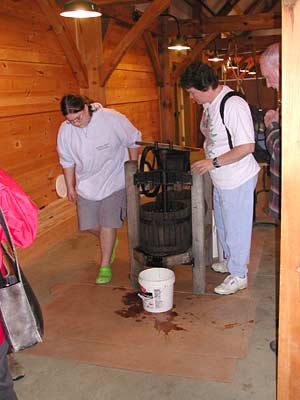We went to the Great Maine Apple Day (or better, this link) at the Maine Organic Farmers and Gardners Association place in Unity on Saturday.
Well! It was different from the Fryeburg Fair! For one thing, there was no traffic. Partly that was because we left Casco just about at 8 AM to get to Unity before things started. Mostly it was because there 1/1000th as many people as at the Fryeburg Fair the previous weekend. I’m figuring 60,000 people at the Fryeburg fair and sixty at Apple Day. This was much more our speed. Look how empty the grounds were when we got there (and what a beautiful fall day it was)!
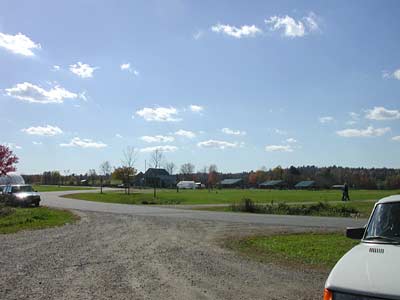
The event was in one large and two medium-sized rooms in one building. The large room was set up with display tables covered with apples; a small food table selling cookies, breadsticks, and soup; a cider press; and about four vendor booths.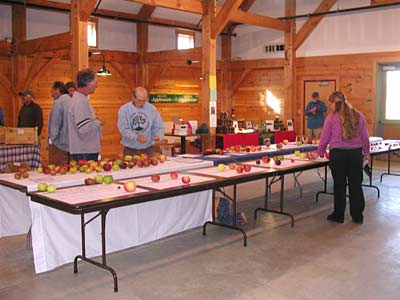
There were several, I think five, talks. We listened to presentations entitled, more or less, “wisdom from an organic orchardist”, “making hard cider”, and “growing fruit trees in Maine.” We skipped the ones on making apple wine and finding old apple trees.
I learned a reasonable amount about apples and apple trees from The Botany of Desire (which by coincidence I bought at Bridgton Books and read in Maine right after it came out, several summers ago.) If you haven’t read it, and you ever read nonfiction, run to your library and check it out.
If you don’t know, apples don’t grow true to type. The display table below showed an extreme example of a parent apple (tiny) and an apple (so big that the variety is called “wealthy”) from a tree that grew from its seed.
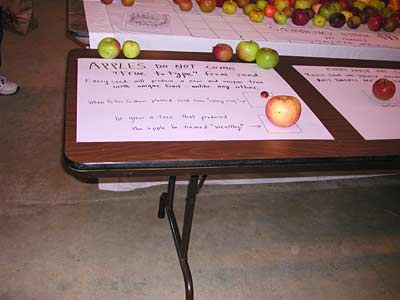
That is, the seeds from a Gala apple won’t grow into Gala apple trees. They won’t even all grow to produce the same variety of apples. Two seeds from the same Gala apple probably won’t produce apples that are much alike at all. In fact, no two apple seeds will grow into trees that produce the same kind of apples. If an eighteenth- or nineteenth-century farmer happened to grow from seed an apple tree that gave good apples, it was like winning the lottery. Shoots of that tree could be grafted onto rootstock from other varieties (grown just for the rootstock! the “growing fruit trees in Maine” talk showed us how that’s done) to produce more of the desirable apples, so those shoots could be sold for good money. All the MacIntosh apple trees in the world are grown by grafting shoots that trace back to one seed; same for Granny Smith, Gala, Fuji …
The other side of that is, there were more varieties of apples than you’ve ever heard of on display on two or three tables in Unity on Saturday. The Botany of Desire talks about the diversity of apple trees that are found in the apple forests of Kazakhstan, where they originated, but seeing the diversity in front of you is a different story entirely.
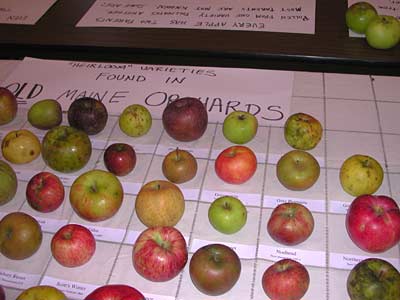
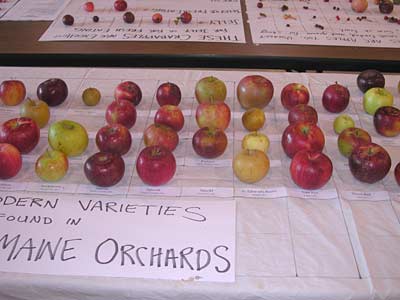
And not just on display. One table had a couple dozen paper plates, each with two or three apples of different varieties, and a paring knife for every four or so plates. You were invited to cut a slice of as many as you wanted and sample them.
Of course, one of the sponsors of the event was a nursery that will sell you any of a huge selection of apple trees, and they’d love nothing better than for everyone who came to the event to order one each of every variety. But there are easier and more secure ways of making a living than growing apple varieties; the people who do it really love it and want to preserve old as well as commercially grown apple varieties. Because the same way that you can only grow a new Gala from a shoot from an old Gala, when the last Briggs Auburn tree dies, there will never be another one.
The best audience participation part was the cider mill. There’s a big crank you can turn to grind up apples. A woman about our age, that is, aging hippie age, (the place was full of people who probably were hanging around Cambridge in the ’60s and ’70s), was tossing apples into the hopper while I cranked. Ground up apples, including peel, stems, and seeds, dropped into one of two cider press barrels below. When one was reasonably full, you turned the other crank to lift the top of the press up from the other barrel, dumped the pressed-out remains (that’s called pomace. Your free vocabulary lesson for the day) to put on a compost heap somewhere, and moved the pulp-filled container under the press. Turn the other crank down, and fresh cider flows out the bottom.
